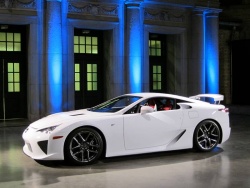 Lexus LF-A. Click image to enlarge |
|
Related articles on CanadianDriver
Manufacturer’s web site
|
Article and photos by Jil McIntosh
Photo Gallery:
Lexus LF-A
Toronto, Ontario – My Lexus LFA is sky blue, with gold-painted calipers and bright wheels. The seats are tan leather, the carpet and the headliner are camel yellow, and the steering wheel matches it all. Alas, it’s not one of the ten that have already been allotted to select buyers in Canada, but for a little while I had some of the feeling of ordering one of my own, at a Lexus event intended to show some “behind the scenes” into this new supercar.
There will only be 500 LFAs built for sale worldwide – about 150 will go to our neighbours south of us – all hand-assembled in Japan at the rate of no more than twenty a month. When the last one rolls out the door, it will mark the end of the model. Still, it’s not just about those five hundred cars by themselves, but about the technology, styling cues and performance that will eventually work their way into other Lexus vehicles. In a way, the LFA is almost a concept car that you can buy, a rolling development instrument with its various proprietary features and technologies.
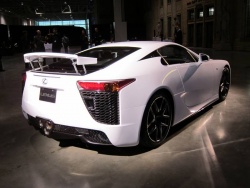 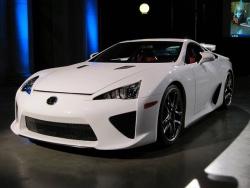 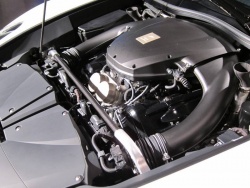 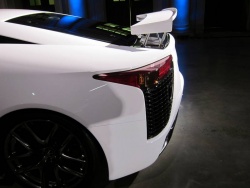 Lexus LF-A. Bottom photo: The rear wing deploys at 80 km/h. Click image to enlarge |
All of this comes with a hefty price tag, of course, and the LFA is $405,500 in Canadian funds. You can bump that up with some of the specialty colours, or for a real treat, add another $75,000 for the Nurburgring Edition, which add another ten horsepower, faster shift speeds, different suspension tuning and unique styling cues, wheels and tires. There are fifty of those, with one coming to Canada.
The LFA name refers to Lexus, to Fuji where it was designed and engineered, and for Apex, as in the pinnacle of achievement, the company said. It uses a front-mounted, LFA-unique 4.8-litre V10 engine, engineered in conjunction with Yamaha Motor Works, producing 552 horsepower and 354 lb-ft of torque. Yamaha also assembles the engine, each one built by a single worker who then signs it. The engine is mated to a rear-mounted six-speed sequential single-clutch gearbox, activated by paddle shifters on the steering wheel. The shift times can be driver-tuned from 0.2 to one second, and the whole system can be dialed into auto, normal, wet or sport. When in that last one, the redline moves up on the LCD tachometer. The LFA can accelerate from zero to 100 km/h in 3.7 seconds to a top speed of 325 km/h. I had to take the company’s word on that, since the car on display was a prototype on loan from Japan for the auto show circuit, and the possibility of a journalist slinking too fast around a corner definitely wasn’t in the cards. I did get to hear it run, though, and there’s certainly a healthy, high-revving roar from the three exhaust tips peeking from under the rear fascia. Although you wouldn’t expect it to be much of a concern at this level, the LFA’s engine can shut off five of its cylinders when not needed, to reduce emissions while idling.
The LFA has been in development for ten years and was originally intended to be rendered entirely in aluminum. Along the way, it was decided that even that lightweight material was too heavy, and so 65 per cent of the chassis is now carbon fibre, for a weight savings of 136 kilograms over aluminum. Everything makes a difference, no matter how small, and so even the hood prop rod is made from the costly cloth, and weighs a mere eight grams. Overall, the car is a flyweight, coming in at a maximum of 1,580 kilograms.







 Follow CanadianDriver on Twitter
Follow CanadianDriver on Twitter



